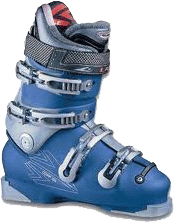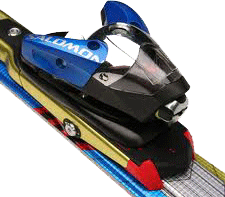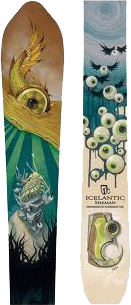Alpine Ski Boots
Alpine Ski Boots have rigid soles and attach to the binding at both toe and heel using ISO DIN standard bindings. Because of the bindings, they forgo rubber soles in favor of hard plastic for better safety and precision. There are three basic types of ski boot which vary in the way the ski boot closes around the lower leg: rear-entry, front-entry, and mid-entry ski boots. Ski boots use the Mondo Point Sizing system, which is based on the metric system.
Front-entry Ski Boots
"Front-entry" boots are the primary boot of choice for performance-oriented skiers. Forward-flex is varied depending upon intended use, but ranges from easily flexed beginner/intermediate boots to extremely stiff boots intended only for racing. Rear-entry Ski Boots
This is the simplest and cheapest type of ski boot and is good for beginners. Recent improvements to front-entry and mid-entry boots, primarily in the areas of comfort and ease of entry/exit, have diminished their popularity, though the mid-range models remain very common as rental boots.
Mid-entry Ski Boots
These combine many of the strengths of both rear-entry and front-entry ski boots. offer much of the performance and versatility of front-entry ski boots. Mid-entry ski boots are recognizable by a wide-opening cuff which opens to the front and to the back.
Shell modification
When the boot is physically stretched to allow for specific feet.
Rear-entry Ski Boots
This is the simplest and cheapest type of ski boot and is good for beginners. Recent improvements to front-entry and mid-entry boots, primarily in the areas of comfort and ease of entry/exit, have diminished their popularity, though the mid-range models remain very common as rental boots.
Mid-entry Ski Boots
These combine many of the strengths of both rear-entry and front-entry ski boots. offer much of the performance and versatility of front-entry ski boots. Mid-entry ski boots are recognizable by a wide-opening cuff which opens to the front and to the back.
Shell modification
When the boot is physically stretched to allow for specific feet.
Alpine bindings
The vast majority of bindings for Alpine skiing work by fixing the ski boot to the ski at the toe and heel. The binding attaches the boot to the ski, but to reduce injury also allows the boot to release in case of a fall. The boot is released by the binding if a certain amount of torque is applied (usually created by the weight of a falling skier).  The amount of torque required to release the boot is adjusted by turning a screw on the toe and heel piece. The torque is based on height, weight, ski boot sole length, the skiing style of the skier (cautious, average, or aggressive) and, age (if the skier is 50 years old or older). Incorrectly adjusted bindings may release prematurely, or may fail to release, creating a potential hazard. Most powder or freestyle skis are sold flat, while most carving and race skis come with an integrated binding system.
Alpine ski bindings employ the use of a snow brake to prevent the ski from moving while it is not attached to a boot. Snow brakes work by the use of a sprung square 'C' shape, typically made of metal, which makes contact with the snow. When a ski boot is put in the ski binding, the brake pivots under the downward pressure and runs parallel with the ski allowing free movement. When the boot comes out of the ski, the brakes spring out perpendicular to the ski and stop the ski from sliding.
The amount of torque required to release the boot is adjusted by turning a screw on the toe and heel piece. The torque is based on height, weight, ski boot sole length, the skiing style of the skier (cautious, average, or aggressive) and, age (if the skier is 50 years old or older). Incorrectly adjusted bindings may release prematurely, or may fail to release, creating a potential hazard. Most powder or freestyle skis are sold flat, while most carving and race skis come with an integrated binding system.
Alpine ski bindings employ the use of a snow brake to prevent the ski from moving while it is not attached to a boot. Snow brakes work by the use of a sprung square 'C' shape, typically made of metal, which makes contact with the snow. When a ski boot is put in the ski binding, the brake pivots under the downward pressure and runs parallel with the ski allowing free movement. When the boot comes out of the ski, the brakes spring out perpendicular to the ski and stop the ski from sliding.
Alpine Skis
Alpine Skis  are made with composite materials, such as carbon-Kevlar, which makes skis stronger, lighter, and more durable. Virtually all modern skis are made with some degree of side cut. The more dramatic the difference between the widths of the tip, waist and tail, coupled with the length, stiffness and camber of the ski, the shorter the "natural" turning radius. There are many types of skis and designs but nearly all modern recreational skis are produced with a large degree of side cut which when leaned on left or right will cause the ski follow the arc and hence turn the skier.
are made with composite materials, such as carbon-Kevlar, which makes skis stronger, lighter, and more durable. Virtually all modern skis are made with some degree of side cut. The more dramatic the difference between the widths of the tip, waist and tail, coupled with the length, stiffness and camber of the ski, the shorter the "natural" turning radius. There are many types of skis and designs but nearly all modern recreational skis are produced with a large degree of side cut which when leaned on left or right will cause the ski follow the arc and hence turn the skier.